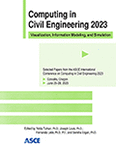Trends and Opportunities for Material Information Sharing: Applying BIM to Support Supply Chain Management in Construction Projects
Publication: Computing in Civil Engineering 2023
ABSTRACT
Due to dynamic organizations and unexpected conditions on project sites, the construction industry has suffered from schedule and cost overruns. Researchers have applied building information modeling (BIM) and supply chain management (SCM) concepts to integrate diverse stakeholders, and further, improve efficiency in construction projects. BIM can support supply chain integration (SCI) by providing reliable up-to-date information on a project, which reduces resource waste and completes the project as planned. Specifically, sharing updated material information, including the state of material fabrication, current location, each material’s due date on site, and site inventory status, is crucial for successful project execution because such data changes often. However, current information sharing via BIM is limited in order to achieve the desired level of supply chain integration. By capturing the state-of-practice and state-of-the-art, this study compiles the status of information sharing using BIM and the suggestions of BIM application against the desired level of information sharing to support supply chain integration. The results provide information sharing maturity in the construction industry and which areas need to be improved to achieve the desired level of information sharing. Based on the results, the study aims to suggest a direction for future research on material information sharing using BIM.
Get full access to this article
View all available purchase options and get full access to this chapter.
REFERENCES
Ala-Risku, T., and Karkkainen, M. (2006). “Material delivery problems in construction projects: A possible solution.” International journal of production economics, 104 (1): 19–29.
Azhar, S., Khalfan, M., and Maqsood, T. (2015). “Building information modeling (BIM): now and beyond.” Construction economics and building, 12(4): 15–28.
Caldas, C. H., Menches, C. L., Reyes, P. M., Navarro, L., and Vargas, D. M. (2015). “Materials management practices in the construction industry.” Pract. Period. Struct. Des. Constr., 20(3): 04014039.
Chen, P., and Nguyen, T. C. (2019). “A BIM-WMS integrated decision support tool for supply chain management in construction.” Automation in construction, 98: 289–301.
Chen, Q., Adey, B. T., Haas, C., and Hall, D. M. (2020). “Using look-ahead plans to improve material flow processes on construction projects when using BIM and RFID technologies.” Construction innovation, 20 (3): 471–508.
CII (Construction Industry Institute). (2021). FR-363 - Modernizing the Supply Chain and Increasing the Value of AWP, Construction Industry Institute, Austin, TX.
Dallasega, P., Rauch, E., and Linder, C. (2018). “Industry 4.0 as an enabler of proximity for construction supply chains: A systematic literature review.” Computers in Industry, 99, 205–225. https://doi.org/10.1016/j.compind.2018.03.039.
Deng, Y., Gan, V. J. L., Das, M., Cheng, J. C. P., and Anumba, C. (2019). “Integrating 4D BIM and GIS for Construction Supply Chain Management.” Journal of construction engineering and management, 145(4).
Eriksson, P. E. (2015). “Partnering in engineering projects: Four dimensions of supply chain integration.” Journal of Purchasing & Supply Management, 21, 38–50.
Gosling, J., Towill, D. R., Naim, M. M., and Dainty, A. R. J. (2015). “Principles for the design and operation of engineer-to-order supply chains in the construction sector.” Production Planning & Control, 26(3): 203–218, DOI: https://doi.org/10.1080/09537287.2014.880816.
Irizarry, J., Karan, E. P., and Jalaei, F. (2013). “Integrating BIM and GIS to improve the visual monitoring of construction supply chain management.” Automation in construction, 31: 241–254.
Le, P. L., Chaabane, A., and Dao, T. (2022). “BIM contributions to construction supply chain management trends: an exploratory study in Canada.” International journal of construction management, 22(1): 66–84.
Li, C. Z., Zhong, R. Y., Xue, F., Xu, G., Chen, K., Huang, G. G., and Shen, G. Q. (2017). “Integrating RFID and BIM technologies for mitigating risks and improving schedule performance of prefabricated house construction.” Journal of cleaner production, 165: 1048–1062.
Liu, X., Wang, X., Wright, G., Cheng, J. C. P., Li, X., and Liu, R. (2017). “A State-of-the-Art Review on the Integration of Building Information Modeling (BIM) and Geographic Information System (GIS).” ISPRS international journal of geo-information, 6(2): 53.
Magill, L. J., Jafarifar, N., Watson, A., and Omotayo, T. (2022). “4D BIM integrated construction supply chain logistics to optimise on-site production.” International Journal of Construction Management, 22(12): 2325–2334, DOI: https://doi.org/10.1080/15623599.2020.1786623.
O’Brien, W. J., Formoso, C. T., Vrijhoef, R., and London, K. A. (2008). Construction supply chain management handbook. CRC press, Boca Raton, FL.
Rudge, S. (2018). “Tag and Track Building Components Through the Utilization of BIM 360 Field.” AU Las Vegas 2018, <https://www.autodesk.com/autodesk-university/class/Tag-and-Track-Building-Components-Through-Utilization-BIM-360-Field-2018#video>(Nov. 12. 2022).
Vrijhoef, R., and Koskela, L. (2000). “The four roles of supply chain management in construction.” European journal of purchasing & supply management, 6(3-4), 169–178.
Wang, X., and Love, P. E. (2012). “BIM + AR: Onsite information sharing and communication via advanced visualization.” Proceedings of the 2012 IEEE 16th International Conference on Computer Supported Cooperative Work in Design (CSCWD). IEEE, 850–855. Web.
Wang, X., Truijens, M., Hou, L., Wang, Y., and Zhou, Y. (2014). “Integrating Augmented Reality with Building Information Modeling: Onsite construction process controlling for liquefied natural gas industry.” Automation in Construction, 40: 96–105. https://doi.org/10.1016/j.autcon.2013.12.003.
Information & Authors
Information
Published In
History
Published online: Jan 25, 2024
ASCE Technical Topics:
- Architectural engineering
- Building information modeling
- Building management
- Construction engineering
- Construction industry
- Construction management
- Construction materials
- Construction sites
- Engineering fundamentals
- Engineering materials (by type)
- Freight transportation
- Information management
- Infrastructure
- Logistics
- Materials engineering
- Project management
- Supply chain management
- Transportation engineering
Authors
Metrics & Citations
Metrics
Citations
Download citation
If you have the appropriate software installed, you can download article citation data to the citation manager of your choice. Simply select your manager software from the list below and click Download.
